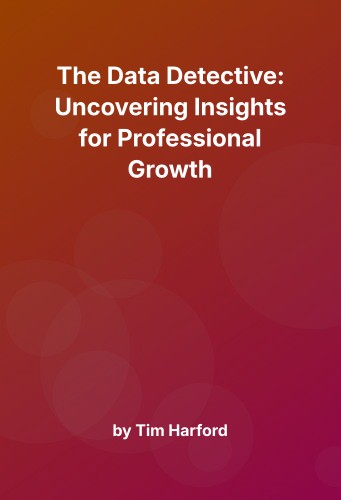The Data Detective: Uncovering Insights for Professional Growth
Introduction: Navigating the Data Landscape
In “The Data Detective,” Tim Harford guides readers through the complex world of data, emphasizing the importance of critical thinking and analytical skills in the digital age. As businesses increasingly rely on data-driven decisions, understanding how to interpret and leverage data becomes essential for professionals across industries. Harford’s work offers a roadmap for navigating this landscape, providing strategic insights that align with modern business needs. This book is a valuable companion to works like “Factfulness” by Hans Rosling, which also emphasizes the importance of data literacy in understanding global trends, and “Weapons of Math Destruction” by Cathy O’Neil, which critiques the potential misuses of data in decision-making processes. Harford’s book stands out by offering actionable insights and practical frameworks for professionals seeking to improve their data interpretation skills.
Building a Foundation: Understanding Data Fundamentals
Harford begins by demystifying the basics of data analysis, highlighting the importance of context and skepticism. He argues that data, while powerful, can be misleading if not properly contextualized. This section draws parallels with Daniel Kahneman’s “Thinking, Fast and Slow,” emphasizing the need for slow, deliberate thinking when interpreting data. Professionals are encouraged to question assumptions and consider the broader context, much like detectives piecing together clues to solve a mystery. For instance, Harford illustrates how misinterpretation of statistical data can lead to flawed business strategies, akin to a detective misreading evidence at a crime scene.
The Art of Asking Questions: Developing a Curious Mindset
A key theme in Harford’s work is the importance of curiosity and the art of asking the right questions. This section explores how professionals can cultivate a mindset that seeks to understand the ‘why’ behind the numbers. By drawing on techniques from investigative journalism and scientific inquiry, Harford provides a framework for developing a questioning approach that can lead to deeper insights and more informed decision-making. For example, he compares this process to the Socratic method, where persistent questioning leads to the uncovering of deeper truths, as also discussed in “A More Beautiful Question” by Warren Berger.
Data Storytelling: Crafting Narratives That Resonate
Harford emphasizes the power of storytelling in making data relatable and actionable. He suggests that data should not just inform but also inspire action. This section explores techniques for crafting compelling data narratives, drawing on principles from Chip and Dan Heath’s “Made to Stick.” Professionals are encouraged to transform raw data into stories that resonate with stakeholders, driving engagement and facilitating change. Harford provides practical examples, such as how successful companies have used storytelling to turn complex data sets into persuasive marketing campaigns.
Bias and Fallibility: Recognizing and Mitigating Cognitive Biases
Understanding and mitigating cognitive biases is crucial for effective data analysis. Harford delves into common biases that can distort our interpretation of data, such as confirmation bias and the availability heuristic. By comparing these insights with those from books like “The Art of Thinking Clearly” by Rolf Dobelli, this section offers strategies for recognizing and countering biases, ensuring more objective and reliable analysis. Harford provides examples from real-world scenarios, such as how biases can affect investment decisions or hiring practices, emphasizing the need for awareness and corrective measures.
Frameworks for Decision Making: Leveraging Models and Tools
Harford introduces several models and tools designed to enhance decision-making processes. This section expands on these frameworks, offering practical applications for professionals. By integrating concepts from agile methodologies and digital transformation, readers learn how to apply these tools in dynamic business environments, enhancing their ability to make data-driven decisions swiftly and effectively. For instance, Harford discusses the use of the OODA loop (Observe, Orient, Decide, Act) in rapidly changing situations, drawing parallels with military strategies and their application in corporate settings.
Embracing Uncertainty: Navigating the Unknown with Confidence
In a rapidly changing world, embracing uncertainty becomes a strategic advantage. Harford encourages professionals to view uncertainty not as a barrier, but as an opportunity for innovation and growth. This section draws on insights from Nassim Nicholas Taleb’s “The Black Swan,” exploring how businesses can build resilience and adaptability by preparing for the unexpected. Harford suggests practical steps for cultivating a culture of experimentation and learning, where failure is seen as a stepping stone to success rather than a setback.
Ethical Considerations: Navigating the Moral Landscape of Data
As data becomes more integral to business operations, ethical considerations become paramount. Harford addresses the moral implications of data use, advocating for transparency and accountability. This section provides a framework for ethical data practices, drawing on contemporary discussions around privacy, consent, and the responsible use of technology in the workplace. Harford stresses the importance of ethical leadership and the role of corporate governance in ensuring that data practices align with societal values and legal standards.
Final Reflection: Transforming Insights into Action
“The Data Detective” concludes with a call to action for professionals to transform insights into meaningful change. Harford’s work equips readers with the tools and mindset needed to navigate the data-driven world confidently. By synthesizing the book’s key themes and insights, professionals are empowered to harness the power of data, driving innovation and strategic growth in their organizations. The integration of lessons from related texts like “Thinking, Fast and Slow,” “Factfulness,” and “Weapons of Math Destruction” enriches the reader’s understanding of data interpretation challenges and opportunities. Harford’s emphasis on curiosity, skepticism, and ethical considerations provides a comprehensive guide for leaders and decision-makers across domains. Whether in business, design, or policy-making, the insights from “The Data Detective” offer valuable perspectives for navigating the complexities of the modern data landscape.

